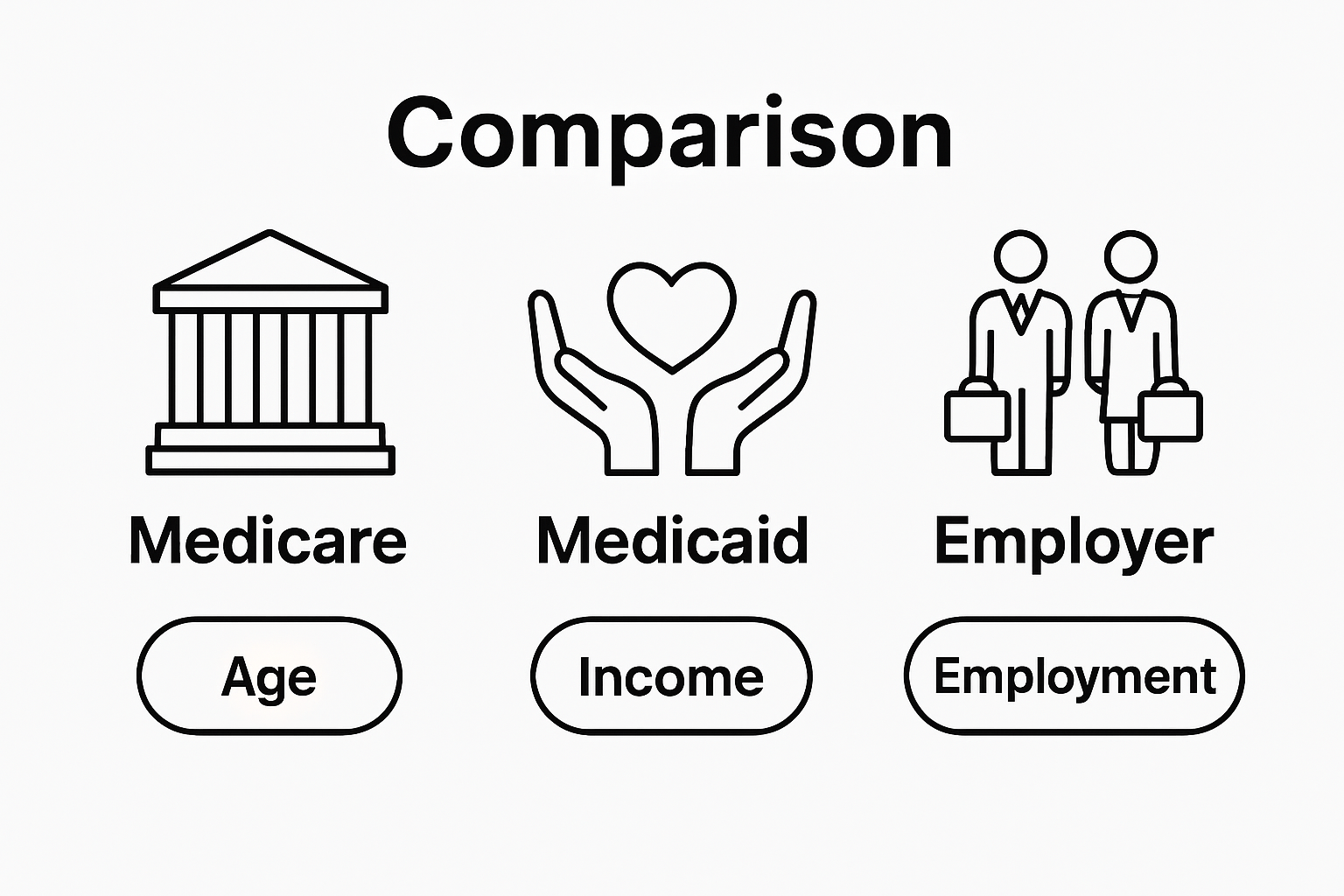Table of Contents
- Defining Health Insurance: What It Is And Its Purpose
- The Importance Of Health Insurance: Why You Should Care
- Types Of Health Insurance In The U.S.: An Overview
- How Health Insurance Works: Key Concepts Explained
- Navigating Health Insurance Options: What You Need To Know
Quick Summary
| Takeaway | Explanation |
|---|---|
| Health insurance mitigates financial risk. | It protects individuals from overwhelming medical expenses, which can lead to financial hardship or bankruptcy. |
| Understand key plan components. | Familiarize yourself with premiums, deductibles, and copayments to effectively manage healthcare costs. |
| Preventive services are crucial. | Having insurance allows access to regular check-ups and screenings, promoting early detection and management of health issues. |
| Evaluate various insurance types. | Knowing the differences between government programs, employer-sponsored plans, and private insurance helps in choosing the best fit. |
| Assess personal healthcare needs. | Consider your medical history and future healthcare requirements when selecting a plan to ensure adequate coverage. |
Defining Health Insurance: What It Is and Its Purpose
Health insurance represents a critical financial protection mechanism that helps individuals manage medical expenses and access healthcare services. At its core, health insurance is a contractual agreement between an individual and an insurance provider where the company agrees to cover a portion of medical costs in exchange for regular premium payments.
The Basic Mechanics of Health Insurance
Health insurance operates on a risk-sharing principle, where many individuals pool their resources to spread out potential medical expenses. According to the Centers for Medicare and Medicaid Services, this system allows people to access healthcare without facing potentially devastating financial consequences from unexpected medical treatments.
Key components of a typical health insurance plan include:
To simplify your plan selection, the following table summarizes the main components of a typical health insurance plan and clarifies their roles in personal healthcare finances.
| Component | Definition | Role in Healthcare Costs |
|---|---|---|
| Premium | Monthly payment for maintaining insurance coverage | Keeps insurance active regardless of use |
| Deductible | Amount you pay before insurance begins covering expenses | Initial out-of-pocket cost responsibility |
| Copayment | Fixed fee for specific services (e.g., doctor visit, Rx) | Your cost at the point of care |
| Coverage Limit | Maximum amount insurance will pay for certain treatments | Sets boundaries on insurer payments |
| Out-of-pocket Maximum | Maximum you pay in a policy year | Limits your total annual spending |
- Premiums: Monthly payments made to maintain active coverage
- Deductibles: Out-of-pocket expenses you pay before insurance starts covering costs
- Copayments: Fixed amounts paid for specific services
- Coverage limits: Maximum amounts the insurance will pay for certain treatments
Understanding Health Insurance’s Primary Purpose
The fundamental purpose of health insurance goes beyond simple financial transaction. It provides critical protection that ensures individuals can:
- Receive preventive care without significant financial barriers
- Access necessary medical treatments without risking personal bankruptcy
- Manage chronic conditions through consistent healthcare
- Protect family financial stability during medical emergencies
By exploring healthcare coverage options, individuals can find plans tailored to their specific health needs and financial circumstances.
The Importance of Health Insurance: Why You Should Care
Health insurance serves as a critical financial safety net that protects individuals from potentially devastating medical expenses. Without adequate coverage, a single unexpected medical emergency could lead to significant financial hardship or even bankruptcy.
Financial Protection Against Medical Costs
Research from the Harvard Medical School indicates that medical expenses are a leading cause of financial strain for American families. Health insurance helps mitigate these risks by providing structured financial support during medical challenges.
Key financial benefits of health insurance include:
- Reducing out-of-pocket expenses for medical treatments
- Providing predictable healthcare costs through fixed premiums
- Protecting personal savings from being depleted by medical bills
- Offering negotiated rates that are typically lower than uninsured rates

Health and Wellness Advantages
Beyond financial protection, health insurance plays a crucial role in promoting overall health and preventive care. Individuals with health insurance are more likely to:
- Schedule regular check-ups and preventive screenings
- Manage chronic conditions more effectively
- Seek timely medical intervention before health issues become serious
- Access specialized treatments and medications
Explore comprehensive coverage options that can help you safeguard both your health and financial well-being. Understanding and selecting the right health insurance plan is an investment in your long-term health and financial stability.
Types of Health Insurance in the U.S.: An Overview
The United States healthcare system offers multiple health insurance options designed to meet diverse individual and family needs. Understanding these different types helps consumers make informed decisions about their healthcare coverage.
Below is a comparison table to help clarify the characteristics, eligibility, and focus of common government-sponsored health insurance programs in the United States.
| Program | Who It Covers | Main Focus |
|---|---|---|
| Medicare | Individuals 65+ and some with disabilities | Older adults and certain disabilities |
| Medicaid | Low-income individuals and families | Financial need |
| CHIP (Children’s Health Insurance Program) | Children in low-income families | Children’s coverage |
| Veterans Health Administration | Military veterans | Veteran healthcare services |

Government-Sponsored Health Insurance Programs
According to the Centers for Medicare and Medicaid Services, the primary government-sponsored health insurance programs include:
- Medicare: Federal health insurance for individuals 65 and older, and some younger people with specific disabilities
- Medicaid: Joint federal and state program providing health coverage to low-income individuals
- CHIP (Children’s Health Insurance Program): Provides low-cost health coverage for children in families that earn too much to qualify for Medicaid
- Veterans Health Administration: Healthcare services for military veterans
Private Health Insurance Options
Private health insurance plans offer several coverage models that cater to different preferences and budgets. The most common types include:
- Employer-Sponsored Plans: Health insurance provided through an individual’s workplace
- Individual Marketplace Plans: Coverage purchased directly through state or federal healthcare exchanges
- Private Health Insurance: Directly purchased plans from insurance companies
Specialized Insurance Plan Types
Beyond standard coverage, specialized insurance plans address specific healthcare needs:
- High Deductible Health Plans (HDHPs): Lower monthly premiums with higher out-of-pocket expenses
- Health Maintenance Organizations (HMOs): Plans requiring members to use network healthcare providers
- Preferred Provider Organizations (PPOs): More flexible plans allowing out-of-network care
Learn more about comparing health insurance plans to find the best coverage for your unique healthcare requirements.
How Health Insurance Works: Key Concepts Explained
Health insurance operates through a complex system of financial agreements, risk management, and healthcare service coordination. Understanding these mechanisms helps individuals navigate their coverage more effectively and make informed healthcare decisions.
Premium Payments and Risk Pooling
According to the Kaiser Family Foundation, health insurance fundamentally relies on risk pooling. Participants pay monthly premiums into a collective fund, which then covers medical expenses for those who require treatment.
Key aspects of premium and cost structures include:
- Premium: Fixed monthly payment to maintain active insurance coverage
- Risk Distribution: Spreading potential medical expenses across a large group of participants
- Collective Financial Protection: Ensuring no single individual bears the entire cost of unexpected medical treatments
- Predictable Healthcare Budgeting: Creating financial stability for both insurers and insured individuals
Coverage Mechanisms and Service Networks
Health insurance plans establish intricate networks and payment structures to manage healthcare delivery. These mechanisms determine how medical services are accessed and reimbursed:
- In-Network Providers: Healthcare professionals and facilities with pre-negotiated rates
- Out-of-Network Coverage: Potential higher costs for services outside approved networks
- Referral Requirements: Some plans mandate primary care physician referrals for specialist treatments
- Preauthorization: Mandatory approval process for certain medical procedures
Claims Processing and Reimbursement
When medical services are rendered, a complex claims processing system determines financial responsibility. This involves:
- Submitting detailed medical billing information
- Reviewing treatment against policy coverage
- Calculating patient and insurance payment responsibilities
- Processing reimbursements to healthcare providers
Get personalized guidance on understanding health insurance complexities to help simplify your healthcare coverage journey.
Navigating Health Insurance Options: What You Need to Know
Selecting the right health insurance plan requires careful consideration of personal health needs, financial circumstances, and long-term wellness goals. The complexity of available options demands a strategic approach to ensure comprehensive and affordable coverage.
Assessing Your Healthcare Needs
According to Healthcare.gov, evaluating your healthcare requirements is the critical first step in selecting an appropriate insurance plan. Understanding your medical history, anticipated treatments, and potential health risks helps narrow down the most suitable options.
Key factors to consider when assessing healthcare needs include:
- Current Health Status: Existing medical conditions and ongoing treatments
- Anticipated Medical Services: Expected doctor visits, prescriptions, and potential procedures
- Family Medical History: Potential hereditary health risks
- Lifestyle Considerations: Age, occupation, and personal health management approach
Comparing Plan Features and Costs
Beyond basic coverage, successful health insurance selection involves a comprehensive analysis of various plan characteristics:
- Monthly Premiums: Regular payment amounts
- Deductibles: Out-of-pocket expenses before insurance coverage begins
- Copayments and Coinsurance: Your share of medical service costs
- Maximum Out-of-Pocket Limits: Total annual healthcare expense cap
- Provider Network: Available doctors and healthcare facilities
Financial Planning and Coverage Strategy
Effective health insurance navigation requires a holistic approach to financial protection and healthcare management:
- Balance between premium costs and potential out-of-pocket expenses
- Consider potential tax credits and subsidies
- Evaluate additional coverage options like dental and vision
- Understand emergency and preventive care coverage
Learn more about maximizing your Medicare coverage to make informed decisions about your healthcare future.
Take the Guesswork Out of Health Insurance with Support from GenerationHealth.me
If you have ever felt overwhelmed by confusing health insurance terms like premiums, deductibles, or copayments, you are not alone. The journey to secure essential coverage can feel frustrating and risky, especially when trying to balance financial protection and access to quality care. Understanding your choices is critical, but navigating the options by yourself can leave important questions unanswered.
Explore North Carolina Health Insurance Carriers to see trusted providers all in one place.

Now is the time to feel confident in your healthcare decisions. Visit GenerationHealth.me to instantly compare plans and get step-by-step help designed for your unique needs. Whether you are searching for ACA Marketplace options, looking into Medicare solutions, or wanting to add dental and vision to your protection, our experts make insurance simple. Get started now and protect your health and your finances with solutions tailored to you.
Frequently Asked Questions
What is health insurance?
Health insurance is a contract between an individual and an insurance provider that offers financial protection against medical expenses in exchange for regular premium payments.
How does health insurance work?
Health insurance operates on a risk-sharing principle where many individuals pool their resources to cover potential medical expenses, allowing insured individuals to receive healthcare services without incurring overwhelming costs.
What are the main components of a health insurance plan?
Key components of a health insurance plan include premiums, deductibles, copayments, and coverage limits, each playing a critical role in how costs are managed and services are accessed.
Why is health insurance important?
Health insurance is essential as it provides financial protection against high medical costs, promotes preventive care, and helps ensure individuals can access necessary treatments without incurring significant debt.
Recommended
- Understanding the Role of Insurance Agents in Healthcare – GenerationHealth.Me Your Online Health Insurance Marketplace
- Understanding Eligibility for ACA Marketplace Coverage – GenerationHealth.Me Your Online Health Insurance Marketplace
- GenerationHealth.me-Compare Medicare & ACA Plans Online | Marketplace – GenerationHealth.Me Your Online Health Insurance Marketplace
- Choosing Dental Insurance in Edmonton: A 2025 Guide for All Needs – Unity Square Dental